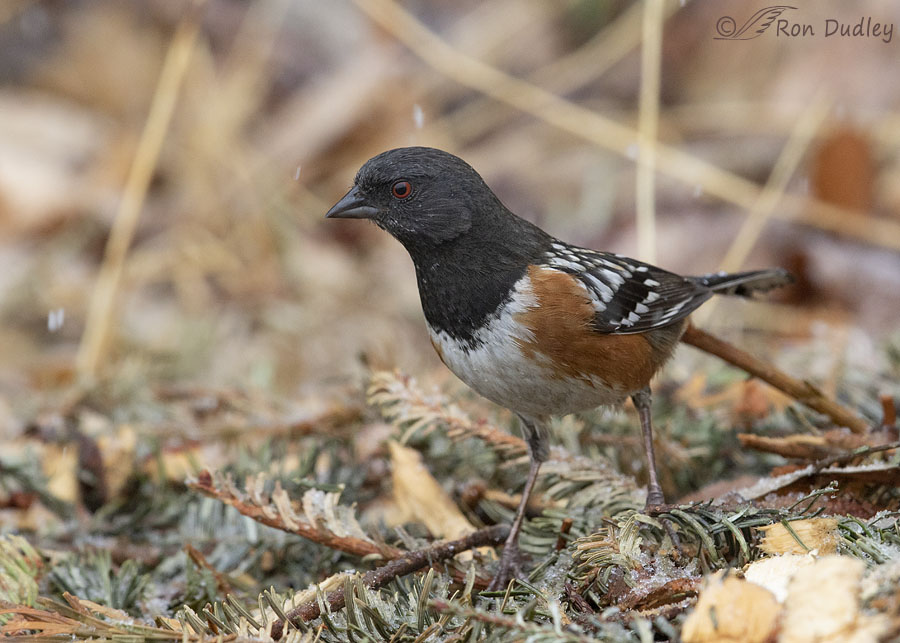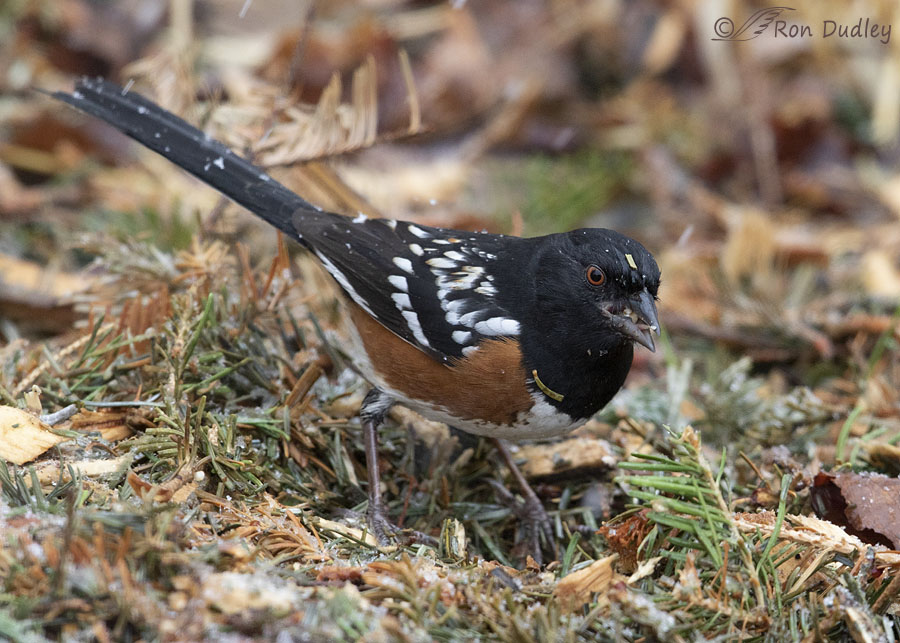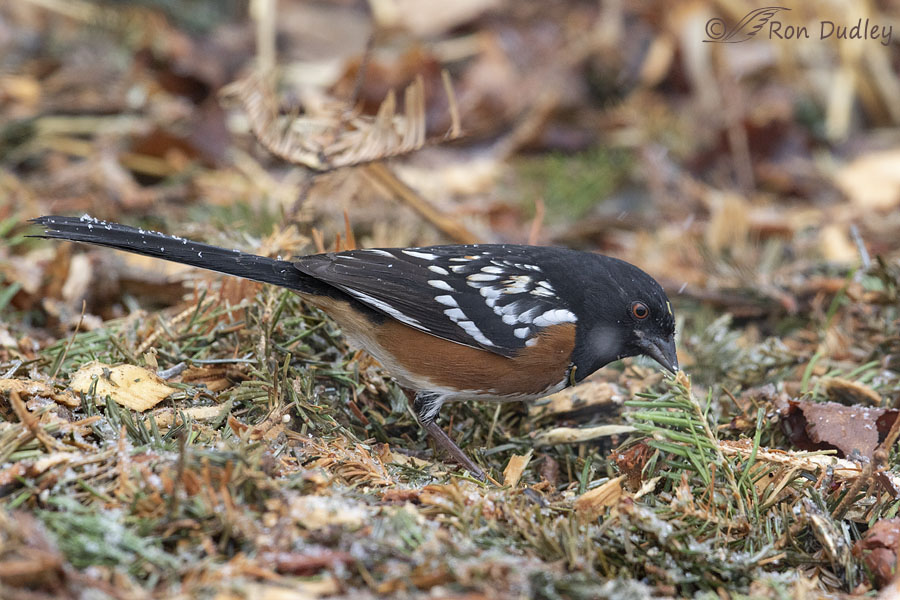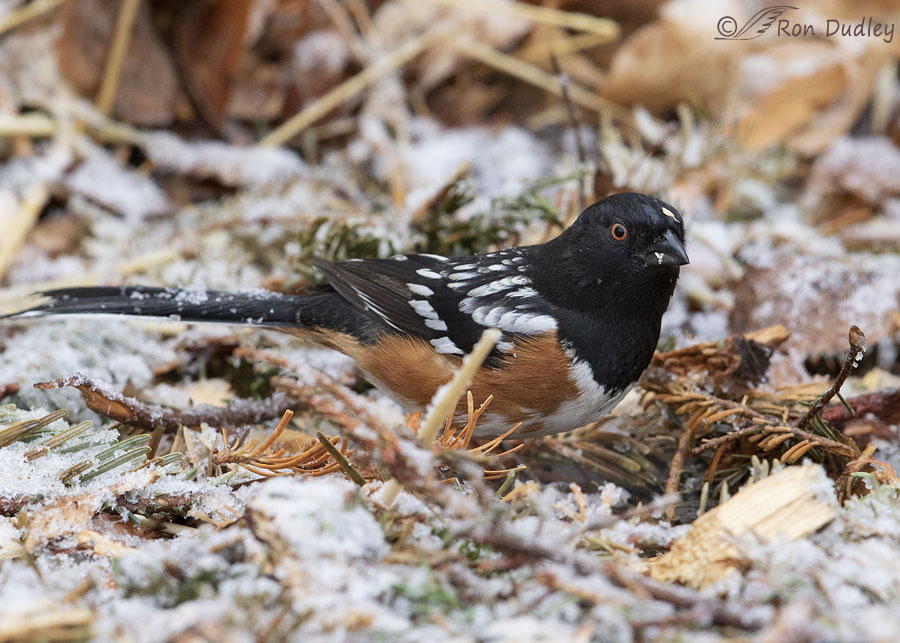Loading up on food before the storm.
Ten days ago as a significant snowstorm approached I went down to the Jordan River looking for birds. My expectations were low because I’d checked out this particular spot many times over the years and never had any luck, not a single time. But it’s great habitat for songbirds so I gave it another shot.

1/320, f/6.3, ISO 800, Canon 7D Mark II, Canon EF 500mm f/4L IS II USM, not baited, set up or called in
To my surprise it was loaded with birds. They were mostly White-crowned Sparrows with a few Dark-eyed Juncos mixed in but eventually a single male Spotted Towhee skulked out of the nearby bushes and joined in the feeding frenzy prior to the storm.
By the time this photo was taken snow was beginning to collect on the needles and leaves on the ground. Here a few falling snowflakes can be seen with one of them looking like it’s about to land on his head.

1/400, f/6.3, ISO 800, Canon 7D Mark II, Canon EF 500mm f/4L IS II USM, not baited, set up or called in
Just a few minutes later snow was beginning to collect on his tail and back. Looking for food while furiously scratching through all that debris is dirty work so he often had bits of plant material stuck to his plumage, as we see here on top of his head.

1/400, f/6.3, ISO 800, Canon 7D Mark II, Canon EF 500mm f/4L IS II USM, not baited, set up or called in
I was actually closer to him than I wanted to be, even with my teleconverter removed. To provide readers a sense of how close I was this photo is full frame (uncropped). When you’re shooting at my focal lengths with the subject this close you have very little depth of field so about the only time I could get the entire bird sharp was when he was broadside to me.
In case you’re curious, that fuzzy whitish spot on his neck is an out of focus snowflake between me and the bird.

1/250, f/6.3, ISO 800, Canon 7D Mark II, Canon EF 500mm f/4L IS II USM, not baited, set up or called in
A few minutes later snow was really building up on the ground and because of the darkening clouds my already slow shutter speed had dropped even more.
Photographing this towhee and the other sparrows in these conditions was an exercise in frustration. Because they were all so hyperactive and I was shooting at such slow shutter speeds most of my photos were much too soft. To make matters worse I kept cutting off or clipping the unusually long tail of the towhee. While I was there I took over 1100 photos but two days ago I trashed all but about three dozen of them. And some of those I kept were marginal..
But it sure was fun and I did manage to get a few keepers. I even learned a few things about photographing frenetic songbirds in such low light.
Ron
Note: I’m always impressed by how birds seem to anticipate weather conditions that will make it difficult to find food so they load up on it just prior to the storm. This snowstorm and another one that came in right on its heels had the ground covered with deep snow for several days, making food extremely difficult to find. Thankfully they’d filled their bellies just in time.
Personally I think birds are far better weather forecasters then their human counterparts on TV.


Outstanding Serie Ron!
Charlotte Norton
I like seeing the accumulation of snow in each successive shot. Glad the little guys were out there munching away before the storm.
Thanks, Marty.
The intensity of color in that last shot…wow. I really like seeing this bird. His fashion sense is on point. 😀
Thank you, Arwen. The towhee thanks you too…
Ron, these closeups are such a treat. Like Lyle, I am suffering bird-feeding withdrawal due to the salmonella outbreak in central Washington. We get these guys in our yard occasionally, so your gorgeous photos allow me to at least pretend I’m watching birds. Thanks so much!
Carolyn, I just emailed you an article by Dan Gleason who argues that it isn’t necessary to take down your feeders and he explains why.
For Dark-eyed Juncos and some other species, a significant drop in temperature, or even a snowfall, triggers a change in the physiology so that more fat is accumulated and more quickly. The liver is working hard to convert those carbohydrates into fat. Fat is the fuel that birds use to keep warm, for migration, or surviving cold nights. With greater accumulation of fat comes an increase in feeding activity. Your observation makes perfect sense.
Thanks for that info, Dan. And for confirming that what I said made sense. That happens by accident once in a while… 🙂
So interesting!
Thanks, Nina.
I KNOW that birds (and critters) more generally are more accurate weather forecasters.
And, if any of us needed a reminder, they also do it much tougher than our wimpy selves in any weather extremes.
Thank you again, as always, for sharing the beauty and the wonder.
“birds (and critters) more generally are more accurate weather forecasters”
That brings the weather loach to mind, EC – a fish that forecasts incoming storm fronts by its behavior.
They are lovely. I enjoy watching the towhees in my yard, I haven’t been able to get decent photos. They like to forage under the evergreen where snow seldom makes it through the branches. During the winter I toss a few live meal worms in the area every morning.
I sure wish I had them in my yard. I’ve never seen on out there, not once.
I bet you had to resist titling this post “Spotted Towhee Scratching Out A Living in Harsh Conditions” (groan).
I had to take down all the feeders for awhile because it’s a Salmonellosis pandemic amongst the Pine Siskins and Purple and House Finches, and because a juvenile Cooper’s hawk found a convenient fast food outlet. The passerines have been gone for days but the raptor abides. The two Spotted Towhees that had been benefitting from all the seed the feeder-birds spilled on the ground have left as well.
Regards,
Birdlorn in Washington
Never even thought of it, Lyle. Should have…
Lyle, I just emailed you an article by Dan Gleason who argues that it isn’t necessary to take down your feeders and he explains why.
Wonderful photos, Ron. 😀 They ARE difficult to capture at any time….. Yes, they are great forecasters. Our most obvious ones a the Grey Crowned Rosy Finches that show up in large numbers when the weather is going to go to hell. Been here a LONG time this winter – unusual as they generally come and go. And yes, all tend to pig out just before a storm…..
Jealous, Judy. I’ve only photographed that species of finch one time. There were a LOT of them but the little buggers never let me get close.
Great photos! I especially like the white of the snow along with the white on the towhee. The rust of the needles and the same rust on the towhee. All so color coordinated! The bits of green keep it from being too much.
“All so color coordinated”
I arranged for all that, Jamila. Not. Thank you.
I loved seeing your Towhees up close–such gorgeous markings ! I miss
seeing them and hearing their ubiquitous scratching from when I lived in Prescott, AZ. As in your note, I’ve noted the feeding frenzy on the part of my backyard birds the afternoon before every storm–they ARE very accurate
little forecasters–their survival must depend upon it !
Kris, I’d love to see a towhee or some other songbird forecasting the weather on TV. I’d pay attention for more reasons than one… 🙂
Spotted Towhees are probably my favorite backyard birds so I really enjoy seeing these outstanding photos. You are right about capturing them without cutting off that long tail. Sometimes I try to follow them while they are moving around the yard at full speed constantly in motion and I think I might have a 50% success rate of keeping that tail in the photos.
In addition to your expert photography and knowledge of biology and science and birds, you have become quite the writer as well. Loved your use of the word “skulked” in that first sentence. It was many years back now, but I still remember hearing that word for the first time in the movie Four Weddings & A Funeral.
Thank you, Everett. You’ve got quite a memory to remember how you learned “skulked” going that far back.
These photos are beautiful! Lovely to see the towhee foraging dappled with snow. I think photographs taken in different light conditions and environments make bird photos all the more interesting. Kudos!
I’m glad you like them. Thanks, Joanne.